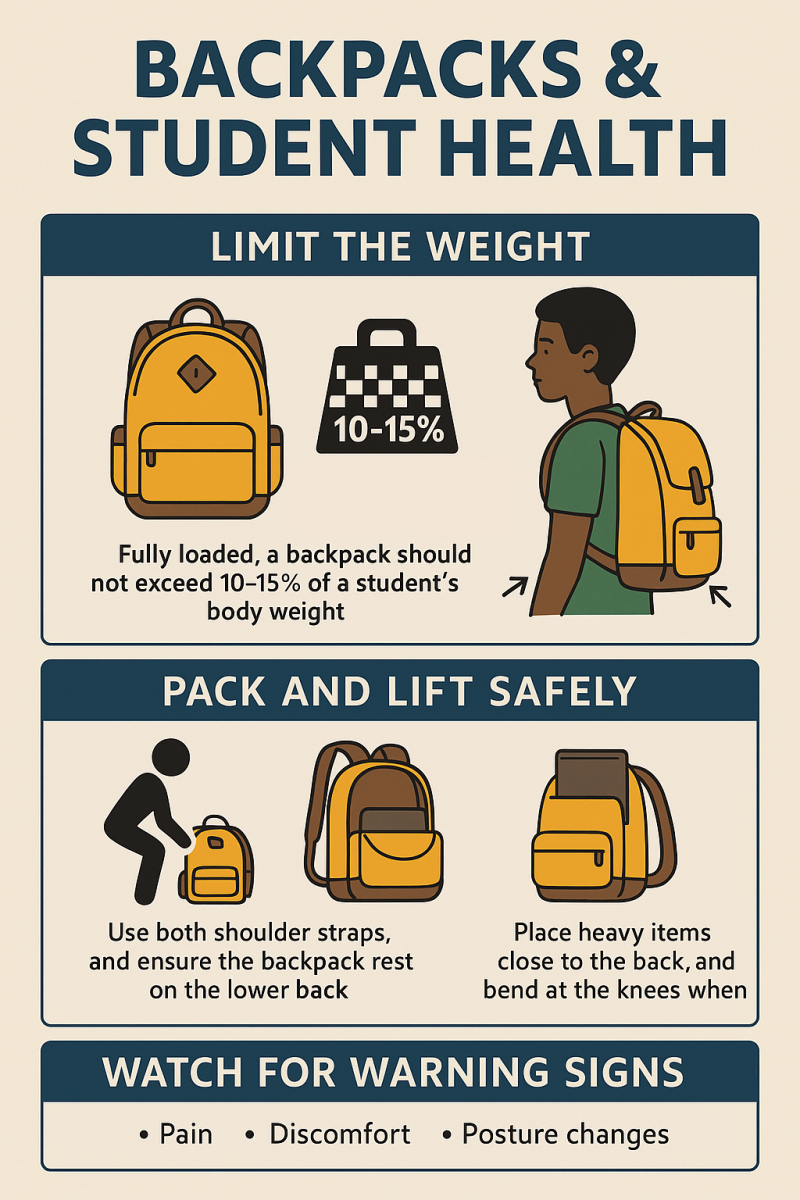
Chat GPT
Tips for healthy Backpack wearing
As schools move away from lockers and students increasingly must carry laptops, heavy textbooks, sports gear, and other equipment, backpacks have become more than just an accessory — they are a health concern. Heavy or improperly carried backpacks can contribute to back, shoulder, neck pain, posture problems, and even long-term musculoskeletal issues. Advisors, teachers, and school leadership have a role in helping prevent these issues. Below are evidence-based guidelines, practical tips, and suggestions for what school communities can do.
What the Research & Experts Tell Us
Based on recent health / physical therapy / orthopaedics sources:
Weight matters: A commonly referenced guideline is that a fully loaded backpack should not exceed 10-15% of a student’s body weight. Above that, risk for discomfort, postural strain, and injury rises. (Therapeutic Associates Physical Therapy)
Proper fit & wear counts:
Use both shoulder straps (not slung over one shoulder), with straps wide, padded, and adjustable. (OrthoInfo)
Backpacks should sit snugly against the back, with the bottom of the pack no more than a few inches (often ~2‐4 inches) below the waist. A bag that hangs too low increases leverage and strain. (Therapeutic Associates Physical Therapy)
Load and organization: Heavier items should be packed close to the spine and lower in the pack. Multiple compartments help distribute weight. Remove unnecessary items. (OrthoInfo)
Lift and move properly: Bend at the knees when lifting the backpack; avoid twisting the body to put it on. Adjust straps so the load is balanced. Careful walking posture helps. (National Spine Health Foundation)
Watch for warning signs: Shoulder, neck or back pain; tingling in arms; red strap marks; posture changes; fatigue. These are signals to reduce load or adjust how the backpack is carried. (Therapeutic Associates Physical Therapy)
What CADA Members Can Do: Practical Steps for Schools & Advisors
Here are actionable strategies for your schools and by extension your students:
Stakeholder
Actions to TAKE
Advisors / Teachers
• Raise awareness: share tips at student assemblies, in newsletters, via posters (“10% rule”, wearing both straps, etc.). • Teach/coach correct use: take a few minutes to demonstrate how to adjust straps, load heavy items close to the back, lift safely. • Encourage students to periodically clean out their backpacks: remove old papers, supplies they don’t need for that day. • Observe and check in: if you see students struggling, offer help (e.g. lighten load, share resources).
School Leadership / Administration
• Policy review: ensure that schedules and curriculum minimize heavy load expectations (e.g. allowing digital textbooks, having copies in class). • Locker alternatives or storage spaces: even if you’ve eliminated lockers, can you provide shared storage in classrooms or grade-level stations? • Budget / procure backpacks or supportive gear: e.g. vouchers for good quality packs, chest or waist straps; consider rolling backpacks if terrain permits. • Training for staff: help everyone understand what good posture/backpack practice looks like so the message is consistent.
Parents & Students
• Weigh backpacks periodically: home check to see if they exceed safe weight. • Choose backpacks with wide padded straps, back padding, waist or chest belts where possible. • Pack smart: put heavy items near the back panel (close to the spine), use all compartments to distribute weight. • Use both straps every time. • Speak up: if there is pain, discomfort, or difficulty, don’t normalize it. Seek adjustments (lighter books, digital alternatives, etc.).
Sample Messaging: What You Could Send to Your Community
Subject: Let’s lighten the load — backpack safety for a healthier school year
Dear Students and Families,
As we gear up for another school year, we want to share some simple but powerful ways to protect your back, shoulders, and posture—especially since many of you are carrying computers, books, and other essentials all day.
Try to keep your backpack at 10% or less of your body weight. You might be surprised how quickly books, devices, and extra gear add up.
Always use both shoulder straps, adjust them so the pack is snug and centered, and make sure the bottom of the backpack doesn’t sit too low.
Pack the heavier items close to your back panel and toward the bottom, and use multiple compartments so the load is balanced.
Whenever possible, leave unnecessary items at home or school. Consider digital resources, lighten the rotation of what you carry.
If you feel pain or discomfort, or your backpack leaves strap marks, let us know. Let’s work together to find solutions.
We want every student to learn in comfort, not in pain. Thanks for helping us lighten the load—literally and figuratively.
Yours in health and education,
[School or District Name]
Why This Matters
Reduces absenteeism or lost concentration due to pain/discomfort.
Prevents long-term musculoskeletal issues or injuries.
Supports equity: students without strong backpacks or ergonomic gear may be disproportionately impacted.
Demonstrates caring, fosters a culture of health and wellness in school.
Health Disclaimer: The information in this article, including text, graphics, and images, is provided for general educational and informational purposes only. It is not intended as a substitute for professional medical advice, diagnosis, or treatment. Students and families should always seek the guidance of a physician or other qualified healthcare professional with any questions or concerns regarding health, posture, or backpack use.